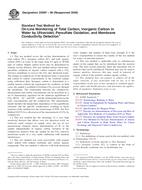Potrebujeme váš súhlas na využitie jednotlivých dát, aby sa vám okrem iného mohli ukazovať informácie týkajúce sa vašich záujmov. Súhlas udelíte kliknutím na tlačidlo „OK“.
ASTM D5997-96(2009)
Standard Test Method for On-Line Monitoring of Total Carbon, Inorganic Carbon in Water by Ultraviolet, Persulfate Oxidation, and Membrane Conductivity Detection
Automaticky preložený názov:
Štandardná skúšobná metóda pre monitorovanie On-Line celkového uhlíka, anorganického uhlíka vo vode pôsobením ultrafialového, persulfát oxidácie, a membrána vodivosť detekcie
NORMA vydaná dňa 1.10.2009
Informácie o norme:
Označenie normy: ASTM D5997-96(2009)
Poznámka: NEPLATNÁ
Dátum vydania normy: 1.10.2009
Kód tovaru: NS-33367
Počet strán: 7
Približná hmotnosť: 21 g (0.05 libier)
Krajina: Americká technická norma
Kategória: Technické normy ASTM
Anotácia textu normy ASTM D5997-96(2009) :
Keywords:
carbon, conductivity, inorganic carbon, membrane, on-line, total organic carbon, Carbon content--water, Impurities--water, Inorganic carbon (IC), Membrane conductivity detection, Online monitoring (in water analysis), Organic carbon (OC), Total organic carbon (TOC), Ultraviolet (UV) analysis--water, ICS Number Code 13.060.50 (Examination of water for chemical substances)
Doplňujúce informácie
| Significance and Use | ||||||||||||
|
This test method is useful for detecting and determining organic and inorganic carbon impurities in water from a variety of sources including industrial water, drinking water, and waste water. Measurement of these impurities is of vital importance to the operation of various industries such as power, pharmaceutical, semiconductor, drinking water treatment, and waste treatment. Semiconductor and power applications require measurement of very low organic carbon levels (TOC < 1 μg/L). Applications in pharmaceutical industries range from USP purified water (TOC < 500 μg/L) to cleaning applications (500 μg/L < TOC < 50 000 μ g/L). Drinking waters range from < 100 μg/L to 25 000 μ g/L and higher. Some of these applications may include waters with substantial ionic impurities as well as organic matter. Measurement of inorganic carbon as well as total organic carbon is highly important to some applications, such as in the power industry. Continuous monitoring and observation of trends in these measurements are of interest in indicating the need for equipment adjustment or correction of water purification procedures. Refer to Annex A1 for additional information regarding the significance of this test method. |
||||||||||||
| 1. Scope | ||||||||||||
|
1.1 This test method covers the on-line determination of total carbon (TC), inorganic carbon (IC), and total organic carbon (TOC) in water in the range from 0.5 μg/L to 50 000 μg/L of carbon. Higher carbon levels may be determined by suitable on-line dilution. This test method utilizes ultraviolet-persulfate oxidation of organic carbon coupled with a CO2 selective membrane to recover the CO2 into deionized water. The change in conductivity of the deionized water is measured and related to carbon concentration in the oxidized sample using calibration data. Inorganic carbon is determined in a similar manner without the requirement for oxidation. In both cases, the sample is acidified to facilitate CO2 recovery through the membrane. The relationship between the conductivity measurement and carbon concentration can be described by a set of chemometric equations for the chemical equilibrium of CO2, HCO3 −, H +, and OH −, and the relationship between the ionic concentrations and the conductivity. The chemometric model includes the temperature dependence of the equilibrium constants and the specific conductances resulting in linear response of the method over the stated range of TOC. See Test Method D4519 for a discussion of the measurement of CO2 by conductivity. 1.2 This test method has the advantage of a very high sensitivity detector that allows very low detection levels on relatively small volumes of sample. Also, the use of two measurement channels allows determination of IC in the sample independently of organic carbon. Isolation of the conductivity detector from the sample by the CO2 selective membrane results in a very stable calibration with minimal interferences. 1.3 This test method was used successfully with reagent water spiked with sodium carbonate and various organic compounds. This test method is effective with both deionized water samples and samples of high ionic strength. It is the user's responsibility to ensure the validity of this test method for waters of untested matrices. 1.4 This test method is applicable only to carbonaceous matter in the sample that can be introduced into the reaction zone. The inlet system generally limits the maximum size of particles that can be introduced. Filtration may also be used to remove particles, however, this may result in removal of organic carbon if the particles contain organic carbon. 1.5 This standard does not purport to address all of the safety concerns, if any, associated with its use. It is the responsibility of the user of this standard to establish appropriate safety and health practices and determine the applicability of regulatory limitations prior to use. |
||||||||||||
| 2. Referenced Documents | ||||||||||||
|
Odporúčame:
Aktualizácia zákonov
Chcete mať istotu o platnosti využívaných predpisov?
Ponúkame Vám riešenie, aby ste mohli používať stále platné (aktuálne) legislatívne predpisy
Chcete vedieť viac informácií ? Pozrite sa na túto stránku.




 Cookies
Cookies
